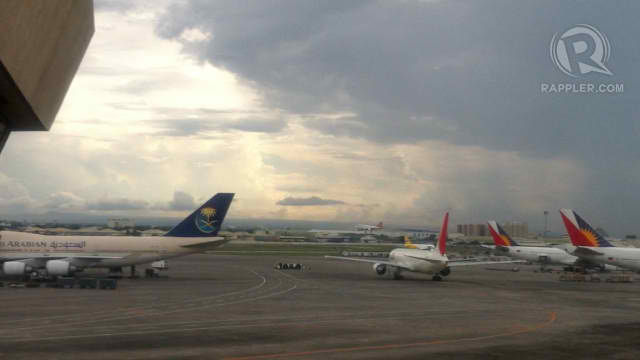SUMMARY
This is AI generated summarization, which may have errors. For context, always refer to the full article.

MANILA, Philippines – A local airline is bracing for an upcoming deadline: the reduction of flights originating from or landing into Ninoy Aquino International Airport (NAiA) by 30% starting July.
According to local budget carrier Zest Airways chief marketing and sales officer Alfredo Herrera, the government has asked the local airlines to reduce their flights in Manila airport, the country’s current main gateway.
“The government has mandated us to reduce flying out of Manila by 30% across-the-board, effective July 5,” the airline executive said in a press briefing on Monday, June 11.
This date was discussed during a technical working group meeting among airline representatives last week, he said.
The low-cost airline, which counts its slots at NAIA as its main asset, said this new directive will force them to rationalize its fleet.
He said this has led them to cease flying to Virac, Catarman, and Calbayog by July. Their operations at Marinduque, Masbate, Busuanga and Tablas in Romblon would likewise be stopped by October.
Shake up
Transportation Secretary Mar Roxas has already announced these NAIA-related rationalization plans way back in May.
The local industry is going through a shake up as the transportation department and its agencies cope with growing consumer complaints on both infrastructure and airline practices.
Aside from the NAIA flight issues, the Civil Aeronautics Board (CAB) has also suspended the industry practice of overbooking and has ordered airlines to allow refunds and rebooking of domestic flights.
The airlines are asking for consideration before these twin orders are finalized on June 15.
Voluntary or an order?
In a text message to reporters on Monday, Transportation Secretary Roxas said the looming implementation of the NAIA flight rationalization plan is voluntary.
“The airlines, all of them — knowing the limitations of the NAIA runway, realizing that, among themselves, their scheduled flights already exceed the runway safety limits, seeing the effect of this in delays (more fuel expended, disrupted operations and angry passengers) — all voluntarily hired and subjected themselves to a common independent flight/slot scheduler who rescheduled their flights during peak hours towards off peak,” Roxas stressed.
Nonetheless, airlines are taking preparations. “We are just being pro-active. Cebu Pacific had said that it will not reduce their flights unless something is put in writing,” said Herrera when asked if the government already issued a black and white order after last week’s meeting.
Cebu Pacific has declined to comment.
Reduce or re-align?
A check with the Civil Aeronautics Board (CAB) confirmed, however, that changes in the slots for take off and landings are underway at NAIA.
CAB executive director Carmelo Arcilla stressed that the changes involve not an across-the-board reduction in local flights, but are just meant to re-align the operations of airlines during peak hours.
“It is not totally going to reduce their flights but rather transfer the ones that will be affected to other slots or to a different time,” Arcilla explained.
This involves freeing up slots during peak hours (7 a.m. to 6 p.m.), and shifting bulk of the load to off-peak hours.
Earlier, the airlines were not keen on this since this involves leaving from or arriving at domestic airports at dusk or just before dark.
Some provincial airports have no night-landing capacity–a problem that the Transportation Department had said they will try to solve.
Delayed flights
NAIA’s criss-crossed 40’s era runway can only accommodate an average of 36 takeoffs and landings per hour. However, actual scheduled commercial and general aviation flights went to as high as 50 events per hour during daytime this summer passenger season.
This current number of runway movements translates to over a dozen delayed flights per hour, which in turn leads to further congestion at the airport terminals, which are themselves already operating beyond capacity.
Domestic flights account for 80 of load of runway. Roxas has said that this is the biggest challenge at NAIA, “so we will cut in that area.”
Private jets
Previously, airlines contested the plan, pointing finger to the general aviation operations as the culprit. These private jets of the country’s richest and flying schools, which take up around 17% of the runway movements, should be transferred elsewhere.
President Aquino had suggested moving these non-commercial operations to alternative airports, like Sangley Point in Cavite.
The NAIA airport is located right smack in the capital and has no more room to grow. The airlines, on the other hand, have grown their operations by leaps and bounds.
Based on DOTC data, commercial airlines doubled their fleet from 62 in 2008 to 119 at present. In 2006, airlines only serviced 18 million passengers, but this grew to 30 million last year.
Takeoffs and landings at NAIA also increased to 255,000 in 2011 compared to 171,000 in 2006.
Since the industry’s growth also benefits the government’s tourism aggressive tourism targets, the government has to do a delicate balancing act.
Other airports outside of Metro Manila are being promoted, including Clark in Central Luzon, Cebu in Visayas, and others.
Manila, however, remains the most profitable destination in the country, and most of the local airlines have their main hubs in the airport’s 3 terminals there.
Preparations
Zest Air’s Herrera said that their preparations include their own fleet rationalization.
“We will run one type of fleet by October this year… This means that we will operate Airbus A320s,” he said.
“We will maximize the use of Manila slots for aircraft that makes economic sense,” he added. – Rappler.com
Click on the links below for related stories:
Add a comment
How does this make you feel?
There are no comments yet. Add your comment to start the conversation.